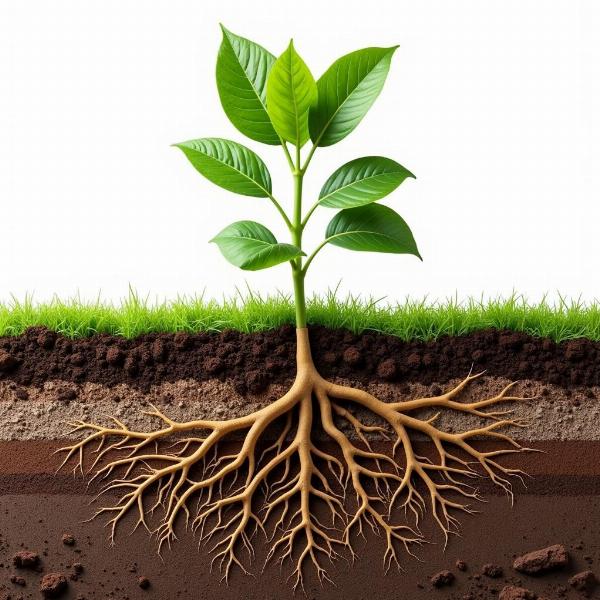Understanding the term “subsoil” and its Hindi equivalent is crucial for anyone involved in agriculture, construction, or environmental studies in India. This article will delve into the meaning of “subsoil” in Hindi, exploring its various aspects, significance, and related terminology. We’ll also discuss the importance of subsoil for plant growth and its role in various industries.
What is Subsoil and Its Meaning in Hindi?
Subsoil is the layer of soil beneath the topsoil. It’s typically less fertile than topsoil and contains more compact, weathered rock fragments. In Hindi, “subsoil” is commonly translated as “उपमृदा (upamṛdā).” Other terms like “अधोमृदा (adhomṛdā)” can also be used, although less frequently. The word “upamṛdā” literally translates to “under-soil,” accurately reflecting its position below the topsoil.
Importance of Subsoil in Agriculture
Subsoil plays a vital role in plant growth, especially for deep-rooted crops. It provides anchorage, stores moisture, and contains essential minerals, though often in less readily available forms than topsoil. Understanding the characteristics of subsoil is vital for farmers to implement appropriate irrigation and fertilization strategies. For instance, knowing the water retention capacity of the subsoil helps determine irrigation frequency and volume. Similarly, analyzing subsoil nutrient content informs decisions about fertilizer application. Choosing crops suitable for the specific subsoil type can significantly impact yield and overall farm productivity.
 Subsoil and Agriculture
Subsoil and Agriculture
Subsoil in Construction and Other Industries
Beyond agriculture, subsoil is a critical consideration in construction and other industries. Its properties, such as compaction and drainage, influence the stability of foundations and other structures. Geotechnical engineers analyze subsoil characteristics to ensure the safe and effective design of buildings, roads, and other infrastructure projects. In river valley meaning in hindi, understanding the subsoil is especially crucial for flood control and irrigation projects.
Subsoil Analysis and Its Significance
Analyzing subsoil composition is crucial for various applications. It helps determine its suitability for construction, assess its agricultural potential, and understand its impact on the environment. Experts like Dr. Anjali Sharma, a leading soil scientist, emphasize the importance of regular subsoil testing: “Subsoil analysis provides valuable insights into the long-term health and productivity of land. It’s an essential tool for sustainable land management.”
Understanding Subsoil Texture and Composition
Subsoil texture and composition vary considerably depending on the parent material, climate, and other environmental factors. It can range from sandy and well-drained to clayey and poorly drained. Knowing the texture and composition helps determine the appropriate land use and management practices. For instance, clayey subsoil might require amendments to improve drainage and aeration for optimal plant growth. In hindi meaning of sawdust, knowing the composition of the underlying subsoil is crucial for waste management and land reclamation.
Conclusion
Understanding “subsoil meaning in Hindi” and its various aspects is crucial for sustainable land management and various industrial applications. From agriculture to construction, a thorough understanding of subsoil properties is essential for informed decision-making. This knowledge helps maximize agricultural productivity, ensure the stability of structures, and contribute to responsible environmental practices.
FAQ
- What is the main difference between topsoil and subsoil? Topsoil is the uppermost layer rich in organic matter, while subsoil is less fertile and contains more weathered rock fragments.
- Why is subsoil important for plant growth? Subsoil provides anchorage, stores moisture, and contains essential minerals necessary for plant growth.
- How does subsoil analysis help in construction? Subsoil analysis helps determine its load-bearing capacity and suitability for foundations and other structures.
- What is the Hindi word for subsoil? The most common Hindi word for subsoil is “उपमृदा (upamṛdā).”
- How does subsoil affect drainage? The texture and composition of the subsoil significantly influence water drainage and aeration.
- What is the role of subsoil in land diversion meaning in hindi? Understanding subsoil properties is crucial for assessing the impacts of land diversion on soil health and productivity.
- How does understanding subsoil help in plantation agriculture meaning in hindi? Knowing the subsoil characteristics helps choose suitable crops and implement appropriate irrigation and fertilization practices for plantation crops.
Meaning-Hindi.in is your one-stop solution for professional Hindi translation services. We specialize in various domains, including business and commercial documents, legal and certified translations, technical manuals, website localization, educational and academic materials, and specialized translations. We also offer express translation services for urgent needs. Our expert linguists and cultural advisors ensure accurate and culturally sensitive translations tailored to your specific requirements. Contact us today for all your Hindi translation needs at [email protected] or call us at +91 11-4502-7584. Meaning-Hindi.in is dedicated to bridging the language gap and fostering clear communication.